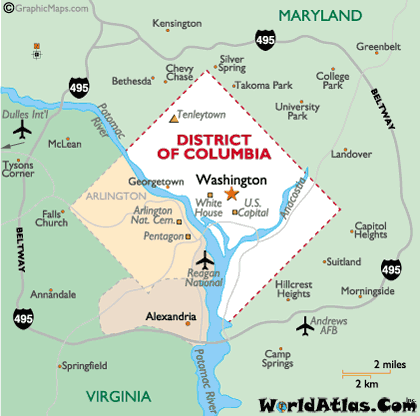
The health care buzz has returned to Washington after a month and a half lull following the Senate’s passage of their health care bill on Christmas Eve. As we roll out of February I figured we’d “March” on into some Washington, D.C. history to show you that partisan politics and young professionals aren’t the only trademark of the city…
Thanks, but no thanks Virginia. Maryland will do
First off, Washington, D.C. has a very unique history. Unlike major metropolises that sprung up in colonial America, such as Philadelphia and New York, Washington, D.C. did not exist even in thought until 1787. The District of Columbia, or as it was known then, Federal City, was actually created in theory by the U.S. Constitution in Article 1, Section 8: “[The Legislative branch shall have the power] to exercise exclusive Legislation in all Cases whatsoever, over such District (not exceeding ten Miles square) as may, by Cession of particular States, and the acceptance of Congress, become the Seat of the Government of the United States.” The states that the Constitution speaks of end up being Maryland and Virginia, the two states straddling the Potomac River. Many may ask, why is Washington, D.C. where it is? Why isn’t it in the middle of the country? Why didn’t the founders use an existing city like New York?
There are several answers. First, D.C. was in the middle of the country. It is pretty much smack dab in the middle of the 13 original colonies. It also lies on a major waterway, which was a huge source of transportation and commerce. James Madison also argued that a new city was needed for security reasons to avoid mob riots in existing cities. Also, before there was anything built on the swampland that became Washington, D.C., New York City was the capital of the country. It was not until 1800, under the presidency of John Adams that any branch of government moved into the new city. The founders desired the country’s capital to lie on new ground, free from the existing culture of any one particular city. Finally, Washington is a unique city because it was built top-down, rather than bottom-up. That is to say, Washington was designed and laid out in 1791 pretty much exactly how it looks today… except that it’s missing the original southern half…
Which leads me to the retrocession. I am going to do this in timeline format so it is easier to follow:
1787-1791: A federal city is mentioned in the Constitution and remains a pretty sweet idea until G. Dubs (not Bush, George Washington in case there’s any confusion) pulled a Kennedy and said “by the end of this decade, I want a man on the moon.” … err I mean, “I want a place for all branches of government to conduct business.” Washington hires (and then fires) Pierre L’Enfant as the primary architect of the city.
1793-1800: Construction. In 1793, Washington laid the cornerstone of the Capitol building. (Side note: “Capitol Hill” and the Capitol building itself are some of the very few correct ways to use this spelling. Jefferson used this spelling in reference to the Capitoline Hill, which was the seat of the ancient Roman Senate). Maryland and Virginia both voted to cede land to create the District of Columbia. It is important to note that originally there were several separate entities: the city of Washington (downtown federal center), the county of Washington (MD area north of the river), the county of Alexandria (VA area south of the river), and Georgetown. Georgetown existed as an establishment before the creation of the District, therefore it remained its own locale until 1871.
1800-1845: Washington City within the District of Columbia became the center of government with the Capitol building (housing Congress and the Supreme Court) and the White House on the north side of the river. Consequently, Alexandria county to the south fell into a state of neglect. Unhappy with their conditions, residents in this area protested for action to be taken.
1846: Action was taken. Congress approved what is now called the Washington, D.C. retrocession of Virginia. In essence, all lands ceded by Virginia were given back to the state. The District ended the slave trade in 1850, while its neighbor across the river, Alexandria, now became slave territory.
1871: Congress passed the Organic Act of 1871 that merged Washington City, County, and Georgetown into one entity, the District of Columbia.
1961-present: The 23rd amendment to the Constitution FINALLY allows residents of D.C. to vote for president. Today, the quest for full voting rights and representation continues. Some proposals include using Washington, D.C. as a “congressional district” of Maryland for voting purposes, while still retaining its own self-government. Another suggests simply making it a 51st voting state, or even a retrocession of D.C. back to Maryland. Nothing has passed to date, and the debate rages on with D.C. residents donning the license plates “Taxation Without Representation.”
Truly fascinating. I suspect most had no idea about the "counties" of DC.
ReplyDeleteI would just like to say, as a resident of DC, that we do not want to be part of Maryland! You all can keep your state just the way it is and we will just become our own. :)
ReplyDeleteLee- you left out the part about Jay Street - I propose a post about the design of DC (with its many circles) and the fabulous story about Jay street!
ReplyDeleteLee - found that entry to be particularly interesting. Even down to the etymology behind the name "Capitol" Building/Hill, etc.
ReplyDeleteLee, I love the blog.
ReplyDeleteAgree with Katelyn, the J Street is a very fun story
ReplyDelete